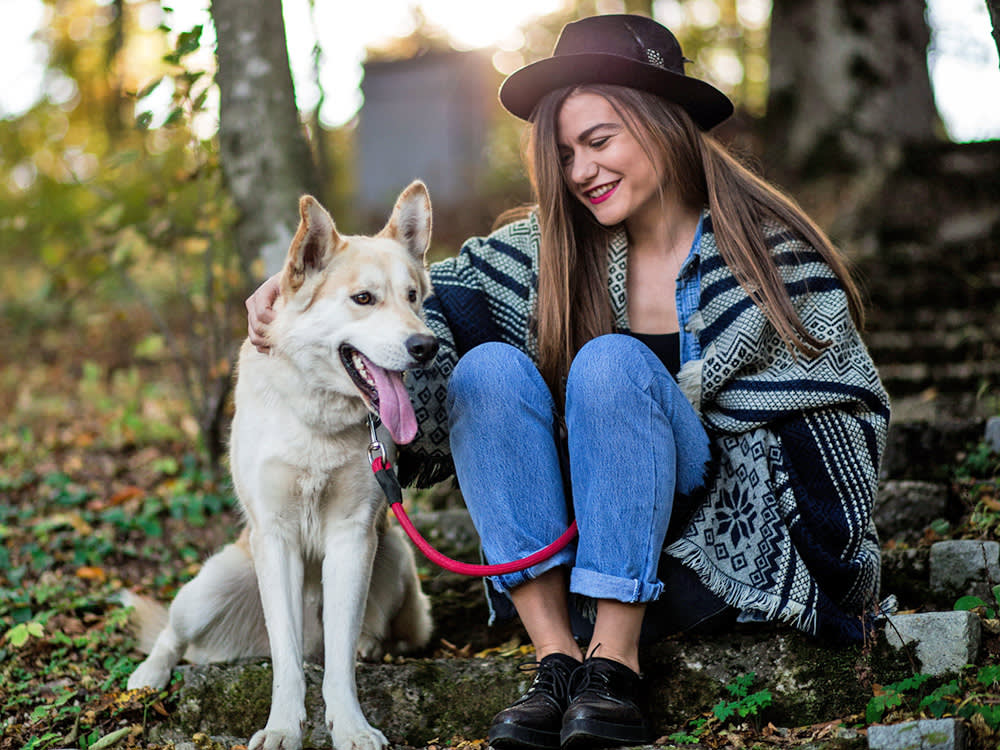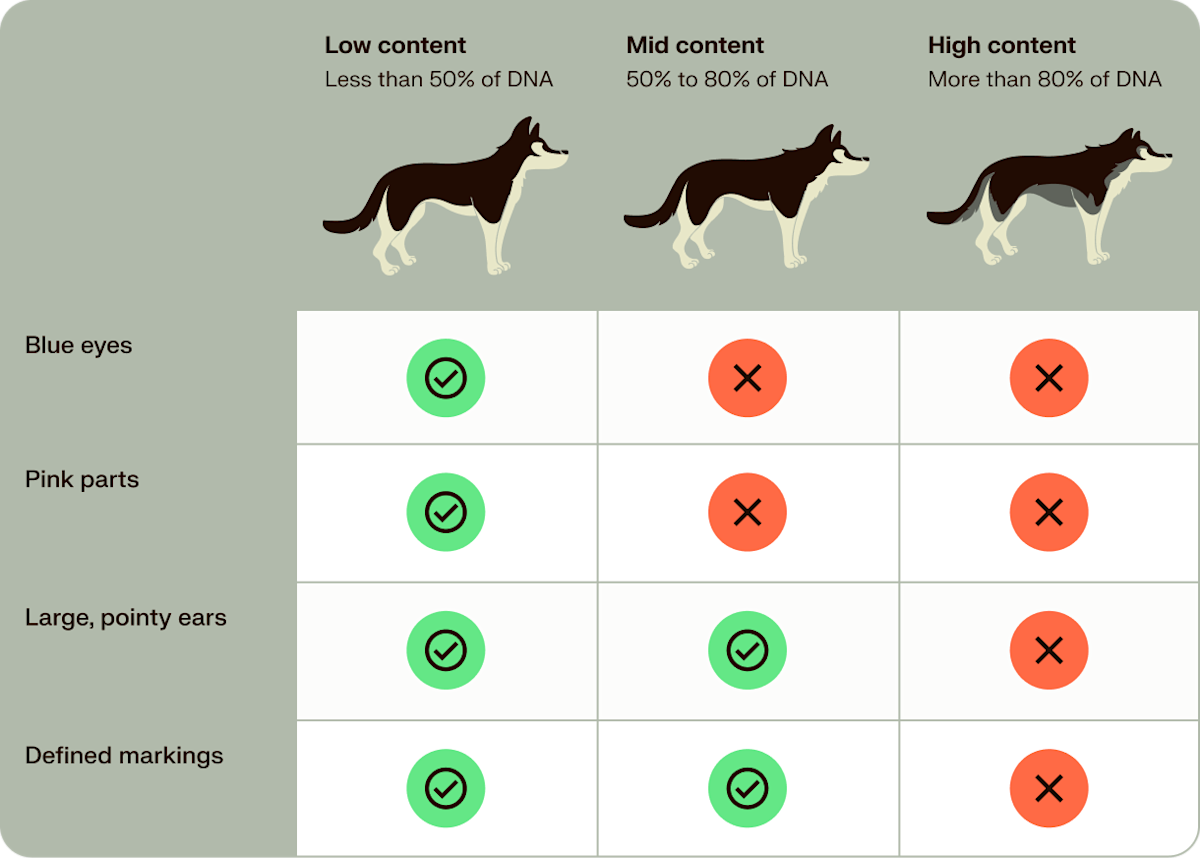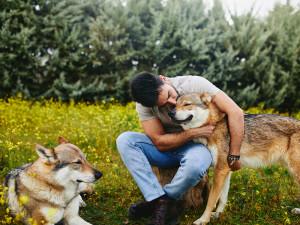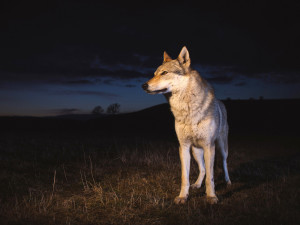Wolfdogs vs. Domestic Dogs
What you need to know about the differences between the two.

Share Article
Most dog lovers are aware that the domestic dogs we know and love today are descended from wolves. But many don’t realize that a mix of the two species exists today: wolfdogs. Wolfdogs are the result of domestic dogs mating with any one of the four wolf subspecies: gray, Eastern, red, or Ethiopian (though the gray wolf mix is the most common).
However, wolfdogs occur less often in the wild than they do in captivity; most of that breed today are intentionally bred as exotic pets, according to the Yamnuska Wolfdog Sanctuaryopens in new tab.
What’s more, most wolfdogs today are not pure hybrids — or the result of a wolf breeding with a domesticated dog — but are the product of breeding two wolfdogs. Therefore, per the organization Wolfdog Awarenessopens in new tab, a wolfdog is any canine who “contains some amount of wolf content and some amount of dog content.”
Key differences between wolves, dogs, and wolfdog hybrids
Wolves, dogs, and wolfdogs all belong to the dog familyopens in new tab (Canidae). However, domestic dogs and wolves belong to different subspecies. Domestic dogs are known as the subspecies Canis familiaris, and there are many subspecies of wolves, including the Gray wolf (Canis lupus) and eastern wolf (Canis lycaon). Wol-fdogs — the result of wolves breeding with dogs — are known asopens in new tab “Canis lupus x Canis lupus familiaris.”

Wolves
Although there are a number of different types of wolves, they all tend to display physical characteristics, such as a sloping forehead and head that is longer than a domesticated dog’s; short, rounded, furry ears; a narrow chest; legs longer than domesticated dogs’ with outward turned wrists; and large and long feet and toes.
In terms of behavior, wolves are highly social animals; they live in packs (among which there are distinct hierarchiesopens in new tab) and have multiple forms of communicationopens in new tab, including facial expressions and tail positions, scenting behaviors, and vocalization.
However, wolves are more social among themselves than they are with humans; in fact, they generally avoid humansopens in new tab. Attacks on humans by wild wolves are rare; between 2002 and 2020, researchers found 26 fatal attacksopens in new tab of wolves on humans around the entire world — and 14 of those were due to rabies.
Dogs
Dogs physically vary quite a bit based on breed but, overall, are smaller than wolves. But a few dog breeds can match or even surpass the average gray wolf, which is considered the largest wolf species. While gray wolves can typically reach heights of between 26 and 32 inches and weigh up to 150 pounds, Great Danes, for example, can reach 32 inches in height and weigh up to 175 pounds.
Dog behavior varies quite a bit between dogs of different breeds and even among dogs of the same breed. However, most domesticated dogs form deep bonds with humans and are notably attentive and responsive to human behavioropens in new tab. This makes sense, given that dogs are widely considered the oldest domesticated animalsopens in new tab.
Wolfdogs
Wolfdogs are classified opens in new tab as ”low,” “mid,” or “high” content depending on the amount of wolf content present in the animal. A low-content wolfdog is generally less than 50 percent wolf and is likely to display few wolf-like characteristics. A mid-content wolfdog is around 50 percent to 74 percent wolf, and may display more wolf characteristics than dog characteristics. High-content wolfdogs can be up to 99 percent wolf and, therefore, are very similar to pure wolves.
It’s important, though, to note that it’s very difficult to definitively determine the true wolf content of a wolfdog. There is no breed registry for wolfdogs and genetic testing is unavailable to most people beyond wildlife management services and law-enforcement agencies (and is not 100 percent accurate even when used).
A wolfdog’s content, therefore, is largely based on phenotyping, or an expert’s evaluation of the dog’s physical and behavioral characteristics. For example, low- and mid-content wolfdogs tend to have large pointy ears and defined markings, whereas high-content wolf dogs do not. Wolfdogs with higher-wolf content tend to beopens in new tab more fearful of humans, have higher prey drives and energy, and are more territorial, destructive, and independent of humans than domesticated dogs.
Most wolfdogs typically weigh between 70 and 100 poundsopens in new tab and have similar life spans to domesticated dogs, typically living between 12 and 15 yearsopens in new tab.
Common wolfdog hybrid breeds
Most wolfdogs today are the result of two wolfdogs bred together in captivity; few wolfdogs occur in the wild, as the result of the natural crossbreeding of a wolf and a domesticated dog. Historically, the domesticated dog breeds most commonly bred with wolves to produce a wolfdog were those already most like wolves. According to the World Animal Foundationopens in new tab, Spitz breeds share the most DNA with wolves. This includes Huskies, Malamutes, Samoyeds, and, perhaps surprisingly, Shih Tzus.
There are also a number of dog breeds that have roots in the crossbreeding of wolves and dogs. For example, the Sarloos Wolfdogopens in new tab was the result of a Dutch breeder crossing a German Shepherd with a European Wolf; the United Kennel Club ropens in new tab ecognized the breed in 2006. The Czechoslovakian Wolfdog (or Czechoslovakian Vlciak) was the product of a German Shepherd and Carpathian gray wolf and is recognized by the American Kennel Club (AKC).
Wolfdog temperament and behavior
Due to the genetic variations among individual wolfdogs, it’s hard to predictopens in new tab an individual wolfdog’s temperament. However, there are some common behavioral traits wolfdogs may inherit from their wolf ancestors, including:
Curiosity: Wolves are territorial and, as such, like to explore their environments. This may result in wolfdogs being more tempted to explore their environments than domesticated dogs. They may do so in destructive ways, such as biting or clawing through furniture in domestic settings.
Drive to roam: Wolves are defensive of their territory, and wolfdogs may inherit the need to guard all the space they consider their turf, rather than stay in one place.
Predatory instinct: Wolves are wild animals, and, as such, have a drive to prey on smaller animals. Wolfdogs may inherit this trait, making them dangerous around other pets and even small children in a home setting.
Especially without proper socialization, wolfdogs may become unpredictable, and they are typically not trainable the way domesticated dogs are. Wolfdogs also have the potential to be dangerous in terms of public health, as the United States Department of Agriculture (USDA) does not approve of the rabies vaccination for wolfdogsopens in new tab.
Do wolfdogs make good pets?
The general consensus is that wolfdogs do not typically make good pets. Wolfdog parents must install very high fences (typically, eight feet high) as well as guards dug along the base of their enclosures to prevent them from escaping. Wolfdogs also tend to be wary of strangers, which makes leaving them with anyone other than the humans with whom they’re familiar difficult.
Many wolfdog parents realize this too late and end up surrendering their wolfdogs to sanctuaries — many of which are currently struggling with capacity and resources.
What’s more, as of 2025, having a wolfdog as a pet is illegal in 13 statesopens in new tab. Three states — Delaware, Indiana, and Virginia — require permits for wolfdog ownership, while others legally allow wolfdog ownership but impose regulations, such as those surrounding specific cage requirements.
References
“About Wolf-DogsS.” WolfPAWS, www.wolfpaws.org/wolf-dogsopens in new tab.
Autin, Beth. “LibGuides: Gray Wolf (Canis Lupus) Fact Sheet: Physical Characteristics.” Ielc.libguides.com, 2024, ielc.libguides.com/sdzg/factsheets/graywolf/characteristics-pageopens in new tab.
Davis, Kimberly, et al. “Why the Rabies Vaccine Should Be Approved for Wolfdogs.” Rutgers University, 2014. https://rucore.libraries.rutgers.edu/rutgers-lib/47946/opens in new tab
“Learn about Wolfdogs | Yamnuska Wolfdog Sanctuary.” Www.yamnuskawolfdogsanctuary.com, www.yamnuskawolfdogsanctuary.com/wolfdogsopens in new tab.
Linnell, John, et al. Wolf Attacks on Humans: An Update from 2002-2020. NINA Report. https://www.wwf.de/fileadmin/fm-wwf/Publikationen-PDF/Deutschland/Report-Wolf-attacks-2002-2020.pdfopens in new tab
“Pack Structure – Wolf Haven International.” Wolfhaven.org, 2015, wolfhaven.org/education/wolves/pack-structure/opens in new tab.
Padilla, Luis R., and Clayton D. Hilton. “Canidae.” Fowler’s Zoo and Wild Animal Medicine, Volume 8, vol. 8, 2015, pp. 457–467, https://doi.org/10.1016/b978-1-4557-7397-8.00046-3opens in new tab.
Shepherd, Jay. “Understanding Wolf Behavior—for Your Safety and Theirs.” Conservation Northwest | Protecting, Connecting and Restoring Wildlands and Wildlife, 31 July 2018, conservationnw.org/understanding-wolf-behavior/opens in new tab.
“Taxonomy Browser (Canis Lupus X Canis Lupus Familiaris).” Nih.gov, 2020, www.ncbi.nlm.nih.gov/Taxonomy/Browser/wwwtax.cgi?mode=Info&id=990119.opens in new tab
Udell, Monique A.R, and C.D.L Wynne. “A Review of Domestic Dogs’ (Canis Familiaris) Human-like Behaviors: Or Why Behavior Analysts Should Stop Worrying and Love Their Dogs.” Journal of the Experimental Analysis of Behavior, vol. 89, no. 2, Mar. 2008, pp. 247–261, https://doi.org/10.1901/jeab.2008.89-247opens in new tab.
“What’s the Difference between Wolfdogs and Wolf Hybrids?” Keller & Keller, 2025, www.2keller.com/library/wolfdog-vs-wolf-hybrid-whats-the-difference.cfmopens in new tab.
“Wolfdog Basics.” Wolfdog Awareness, www.wolfdogawareness.com/wolfdog-basicsopens in new tab.
“Wolfdogs - Cat Tales Wildlife Center.” Cat Tales Wildlife Center, 14 Dec. 2023, www.cattales.org/animals/wolfdogs/opens in new tab.
“Wolfdog Legal States 2025.” Worldpopulationreview.com, 2025, worldpopulationreview.com/state-rankings/wolfdog-legal-statesopens in new tab.

Julie Zeilinger
Julie Zeilinger is a writer and editor whose writing has been published in Marie Claire, Forbes, Vox, HuffPost, and other publications. She is also the author of two books: College 101: A Girl’s Guide to Freshman Year (2014) and A Little F’d Up: Why Feminism Is Not a Dirty Word (2012). She has a two-year-old Bichpoo named Baloo and is a foster mom to dogs via Badass Animal Rescue.


